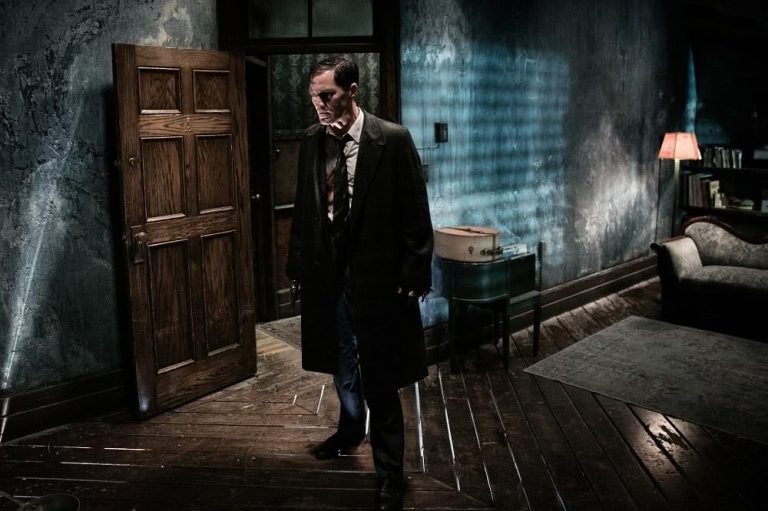Colonel Richard Strickland (Michael Shannon), the antagonist of Guillermo del Toro’s perfect tenth feature, The Shape Of Water, is a character as old as time. He isn’t as much a man as he is the man – the archetypal authority figure, his features as white and mechanical as a clockface. He is the bootheel slapped across the forehead of the oppressed; the apparatus that has driven every totalitarian regime from the Romans, to the Nazis, to Francisco Franco’s Spanish fascists.
Nor is he an entirely new character for del Toro. Just as the auteur’s films all share key themes –imagination versus reality; the horror buried in beauty, and vice versa – so too are his characters one big, multi-species family.
Hellboy, the red-skinned and defiant hero of del Toro’s film of the same name, shares essential DNA with Ofelia, the radical innocent at the heart of Pan’s Labyrinth. Amphibian Man, the gilled love interest that sets the plot of The Shape Of Water in motion, doesn’t just share the slick skin of Hellboy’s Abe Sapien – he shares his complexity, and his psychedelic, touching weirdness. And, importantly, Strickland, with his neatly parted hair, his pressed suits, and his overbearing maleness, is Captain Vidal from Pan’s Labyrinth reborn with a new, fresher face.
Just as he did with Vidal, del Toro communicates Strickland’s complexities with a particular kind of understanding – understanding stripped of any kind of approval. A ladder-climber obsessed with cheap penny candy and self-help books, at the outset of The Shape Of Water Strickland finds himself responsible for caring for “the asset”; an amphibian creature discovered in South America that may or may not be the key to delivering a harsh blow against the Soviets and winning the Cold War.
A most unappreciative surrogate step father, Strickland despises the creature. It’s not hard to see why. The pair are twinned versions of one another; two carefully sketched pictures of the intersection between masculinity and power. Strickland’s authority is artificial: he leads with insults, lascivious, deliberately belittling come-ons directed at The Shape Of Water’s hero, the mute Elisa Esposito (Sally Hawkins), and a particularly phallic cattle prod. And he fucks for the same reason he tortures – to control.
Strickland is several decades worth of soap opera fathers condensed into one Cadillac-driving, God-fearing package.
Meanwhile, the Amphibian Man, with his broad shoulders, and carefully contoured abs, has the kind of strength that only needs to be sparingly used. His early violent episodes come from a place of confusion; then, later, from a need to retaliate. While for Strickland, power and violence serve to subdue the vulnerable, for the Amphibian Man, pain is worthwhile only as a means of protection. And his alien, beautiful sexuality isn’t a tool for violence; it’s a means of healing.
But there is another distinction between the two – a more crucial one. Strickland, one more cog in a colossal, international military machine, is order. And the Amphibian Man, a creature outside the scope of science and the strict confines of Strickland’s fundamentalist religion, is chaos.
There is a cleanness to Strickland’s gelled, all-American surface; a neatness designed to hide the spiritual and moral rot that, in several genuinely stomach-churning scenes, slowly begins to manifest itself physically in him. Strickland is several decades worth of soap opera fathers condensed into one Cadillac-driving, God-fearing package, and his life outside the work he does with the Amphibian Man could be pulled straight from the pages of a furniture catalogue.
He is, at least according to the stereotype, the safest, most reliable kind of American there is: the patriarch. The patriot. The picture of order, and of grace. He is also, of course, a psychopath – a cruel, vengeful monster. In the spiritual system of The Shape Of Water, he is the devil to the Amphibian Man’s God; a clockwork horror, and one more manifestation of the great, horrible cleanness of fascism.
It’s easy then to draw contemporary parallels between the man and the multitude of fascists cluttering up the United States; to see Strickland’s harsh haircut as a visual echo of the style sported by arch neo-Nazi Richard Spencer, or his sexual violence as a mirroring of the behaviour of the President of the United States. But Strickland is not merely a hat-tip to our present. He is an acknowledgement of the terrible allure and longevity of evil; a face slapped onto an ancient force.
In his acceptance speech at the 2018 Golden Globes, at which he won best Director, del Toro noted that throughout his life, monsters had absolved him. He was not talking about monsters like Strickland – those clean-faced lovers of efficiency that could almost be the heroes of another kind of film.
He was talking about monsters like the Amphibian Man; like the creature from the black lagoon; like Frankenstein’s stone-jawed creation. He was talking about beings capable of a form of understanding that only comes from being born different. That, after all, is the great power of The Shape Of Water, the most moving, precise film of the year. It is a film that finds great beauty in isolation, and in difference. And it is a film about a kind of chaotic kindness – a startling, essential compassion – that is as foreign to fascists like Strickland as water is to the surface of the sun.
The Shape Of Water is in Australian cinemas from Thursday January 18. For more film content, read our review of the similarly brilliant Paddington 2.


































